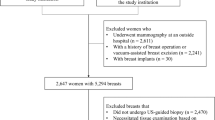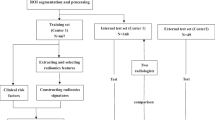Abstract
Purpose
We aimed to determine the ability of contrast-enhanced computed tomography (CECT) texture and histogram analyses to differentiate between benign and malignant thyroid nodules.
Materials and methods
The clinical data from 49 patients with 60 thyroid nodules were retrospectively analyzed. Nodules were classified as malignant or benign based on their histological results. Five texture and histogram parameters of thyroid nodules from CECT images, including entropy, mean, standard deviation, skewness, and kurtosis, were compared and analyzed between the two groups. Regions of interest in axial CECT images were delineated manually by two radiologists. Interobserver agreement in texture and histogram parameters between the two radiologists was assessed using the intraclass correlation coefficient (ICC). The Mann–Whitney U test and receiver operating characteristic curve analysis were conducted to estimate the diagnostic capability of texture parameters.
Results
Interobserver reproducibility (ICC = 0.919–0.969) was excellent. Among the 60 nodules, 36 were malignant and 24 were benign. Entropy of malignant thyroid nodules was significantly higher compared with benign thyroid nodules (P = 0.005). A trend toward a higher kurtosis value was observed in malignant thyroid nodules (P = 0.062). When an entropy value of 6.55 was used as a cutoff for differentiating benign from malignant thyroid nodules, the optimal area under the curve, sensitivity, and specificity were 0.716 (0.585–0.847, 95% confidence interval, P = 0.005), 75.0%, and 62.5%, respectively.
Conclusions
CECT texture and histogram analyses can be used to differentiate benign from malignant thyroid nodules.



Similar content being viewed by others
References
Dean DS, Gharib H. Epidemiology of thyroid nodules. Best Pract Res Clin Endocrinol Metab. 2008;22:901–11.
Haugen BR, Alexander EK, Bible KC, Doherty GM, Mandel SJ, Nikiforov YE, et al. 2015 American thyroid association management guidelines for adult patients with thyroid nodules and differentiated thyroid cancer: the American thyroid association guidelines task force on thyroid nodules and differentiated thyroid cancer. Thyroid. 2016;26:1–133.
Gopinath B, Shanthi N. Computer-aided diagnosis system for classifying benign and malignant thyroid nodules in multi-stained FNAB cytological images. Australas Phys Eng Sci Med. 2013;36:219–30.
Kim D, Kim DW, Heo YJ, Baek JW, Lee YJ, Park YM, et al. Computed tomography features of benign and malignant calcified thyroid nodules: a single-center study. J Comput Assist Tomogr. 2017;41:937–40.
Ben-David E, Sadeghi N, Rezaei MK, Muradyan N, Brown D, Joshi A, et al. Semiquantitative and quantitative analyses of dynamic contrast-enhanced magnetic resonance imaging of thyroid nodules. J Comput Assist Tomogr. 2015;39:855–9.
Yerubandi V, Chin BB, Sosa JA, Hoang JK. Incidental thyroid nodules at non-FDG PET nuclear medicine imaging: evaluation of prevalence and malignancy rate. AJR Am J Roentgenol. 2016;206:420–5.
Frates MC, Benson CB, Charboneau JW, Cibas ES, Clark OH, Coleman BG, et al. Management of thyroid nodules detected at US: society of radiologists in ultrasound consensus conference statement. Radiology. 2005;237:794–800.
Davnall F, Yip CS, Ljungqvist G, Selmi M, Ng F, Sanghera B, et al. Assessment of tumor heterogeneity: an emerging imaging tool for clinical practice? Insights Imaging. 2012;3:573–89.
Ganeshan B, Miles KA. Quantifying tumour heterogeneity with CT. Cancer Imaging. 2013;13:140–9.
Ganeshan B, Abaleke S, Young RC, Chatwin CR, Miles KA. Texture analysis of non-small cell lung cancer on unenhanced computed tomography: initial evidence for a relationship with tumour glucose metabolism and stage. Cancer Imaging. 2010;10:137–43.
Ganeshan B, Goh V, Mandeville HC, Ng QS, Hoskin PJ, Miles KA. Non-small cell ung cancer: histopathologic correlates for texture parameters at CT. Radiology. 2013;266:326–36.
Huang YL, Chen JH, Shen WC. Diagnosis of hepatic tumors with texture analysis in nonenhanced computed tomography images. Acad Radiol. 2006;13:713–20.
Ng F, Ganeshan B, Kozarski R, Miles KA, Goh V. Assessment of primary colorectal cancer heterogeneity by using whole tumor texture analysis: contrast-enhanced CT texture as a biomarker of 5-year survival. Radiology. 2013;266:177–84.
Raja JV, Khan M, Ramachandra VK, Al-Kadi O. Texture analysis of CT images in the characterization of oral cancers involving buccal mucosa. Dentomaxillofac Radiol. 2012;41:475–80.
Zhang H, Graham CM, Elci O, Griswold ME, Zhang X, Khan MA, et al. Locally advanced squamous cell carcinoma of the head and neck: CT texture and histogram analysis allow independent prediction of overall survival in patients treated with induction chemotherapy. Radiology. 2013;269:801–9.
Buch K, Fujita A, Li B, Kawashima Y, Qureshi MM, Sakai O. Using texture analysis to determine human papillomavirus status of oropharyngeal squamous cell carcinomas on CT. AJNR. 2015;36:1343–8.
Scalco E, Fiorino C, Cattaneo GM, Sanguineti G, Rizzo G. Texture analysis for the assessment of structural changes in parotid glands induced by radiotherapy. Radiother Oncol. 2013;109:384–7.
Sollini M, Cozzi L, Chiti A, Kirienko M. Texture analysis and machine learning to characterize suspected thyroid nodules and differentiated thyroid cancer: where do we stand? Eur J Radiol. 2018;99:1–8.
Peng W, Liu C, Xia S, Shao D, Chen Y, Liu R, et al. Thyroid nodule recognition in computed tomography using first order statistics. Biomed Eng Online. 2017;16:67.
Lubner MG, Smith AD, Sandrasegaran K, Sahani DV, Pickhardt PJ. CT texture analysis: definitions, applications, biologic correlates, and challenges. Radiographics. 2017;37:1483–503.
Castellano G, Bonilha L, Li LM, Cendes F. Texture analysis of medical images. Clin Radiol. 2004;59:1061–9.
Liu C, Chen S, Yang Y, Shao D, Peng W, Wang Y, et al. The value of the computer-aided diagnosis system for thyroid lesions based on computed tomography images. Quant Imaging Med Surg. 2019;9:642–53.
Tomita H, Kuno H, Sekiya K, Otani K, Sakai O, Li B, et al. Quantitative assessment of thyroid nodules using dual-energy computed tomography: iodine concentration measurement and multiparametric texture analysis for differentiating between malignant and benign lesions. Int J Endocrinol. 2020;2020:5484671.
Deng Y, Soule E, Cui E, Samuel A, Shah S, Lall C, et al. Usefulness of CT texture analysis in differentiating benign and malignant renal tumours. Clin Radiol. 2020;75:108–15.
Raman SP, Chen Y, Schroeder JL, Huang P, Fishman EK. CT texture analysis of renal masses: pilot study using random forest classification for prediction of pathology. Acad Radiol. 2014;21:1587–96.
Takahashi N, Takeuchi M, Sasaguri K, Leng S, Froemming A, Kawashima A. CT negative attenuation pixel distribution and texture analysis for detection of fat in small angiomyolipoma on unenhanced CT. Abdom Radiol (NY). 2016;41:1142–51.
Funding
This work was funded by the National Key Research and Development Program (2017YFC0113403).
Author information
Authors and Affiliations
Corresponding author
Ethics declarations
Conflict of interest
The authors declare that they have no conflict of interest in this study.
Ethical approval
The retrospective study was approved by the institutional review board, and the requirement for informed consent was waived.
Additional information
Publisher's Note
Springer Nature remains neutral with regard to jurisdictional claims in published maps and institutional affiliations.
About this article
Cite this article
Guo, W., Bai, W., Liu, J. et al. Can contrast-enhancement computed tomography texture and histogram analyses help to differentiate malignant from benign thyroid nodules?. Jpn J Radiol 38, 1135–1141 (2020). https://doi.org/10.1007/s11604-020-01018-z
Received:
Accepted:
Published:
Issue Date:
DOI: https://doi.org/10.1007/s11604-020-01018-z




